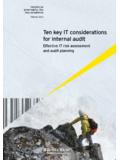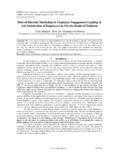Transcription of Cybersecurity and the role of internal audit An urgent ...
1 Cybersecurity and the role of internal audit An urgent call to actionCybersecurity and the role of internal audit An urgent call to action1 Figure 1. Forces of cyber vulnerabilityThe threat from cyberattacks is significant and continuously evolving. One estimate suggests that cybercrime could cost businesses over $2 trillion by 2019, nearly four times the estimated 2015 Many audit committees and boards have set an expectation for internal audit to understand and assess the organization's capabilities in managing the associated risks. Our experience shows that an effective first step for internal audit is to conduct a cyber risk assessment and distill the findings into a concise summary for the audit committee and board which will then drive a risk-based, multiyear Cybersecurity internal audit ascending agenda itemThe forces driving business growth and efficiency contribute to a broad attack surface for cyber assaults (Figure 1).
2 Internet, cloud, mobile, and social technologies, now mainstream, are platforms inherently oriented for sharing. Outsourcing, contracting, and remote workforces are shifting operational control. Data continues to expand along with requirements to protect it. And, attackers can range from hackers to nation states, all continuously innovating and subverting common controls, some beyond the reach of a country s law breaches, combined with growing government focus on cyber threats, have increased concern among corporate audit committees and boards of directors. Under US Securities and Exchange Commission (SEC) guidance, public companies are expected to address potentially material Cybersecurity risks and cyber incidents in the Management s Discussion and Analysis of Financial Condition and Results of Operations (MD&A).
3 2 Amid ever-growing concerns about cyberattacks affecting the nation s critical infrastructure, President Obama s Executive Order (EO) 13636, Improving Critical Infrastructure Cybersecurity , has highlighted the role of businesses in improving the nation s Cybersecurity framework and the need to adapt to rapidly changing regulatory agency expectations and lines of defenseBusiness units and the information technology (IT) function integrate cyber risk management into day-to-day decision making and operations. This comprises an organization s first line of defense. The second line includes information and technology risk management leaders who establish governance and oversight, monitor security operations, and take action as needed, often under the direction of the chief information security officer (CISO).
4 Technology expansionMotivated attackersEvolving business modelsData growthCyber riskIncreasingly, many companies are recognizing the need for a third line of cyber defense independent review of security measures and performance by the internal audit function. internal audit should play an integral role in assessing and identifying opportunities to strengthen enterprise security. At the same time, internal audit has a duty to inform the audit committee and board of directors that the controls for which they are responsible are in place and functioning correctly, a growing concern across boardrooms as directors face potential legal and financial why and how of cyber-risk assessment and defenseExploring an organization s cyber risks begins with three key questions: Who might attack?
5 Are the perpetrators criminals, competitors, third party vendors, disgruntled insiders, agenda-driven hackers, or someone else? What are they after, and what business risks need to be mitigated? Do they want money or intellectual property? Is their goal to disrupt the business or ruin our reputation? Could health and safety risks be created?What tactics might they use? Will they go phishing, test system vulnerabilities, use stolen credentials, or enter networks through a compromised third party? Cybersecurity and the role of internal audit An urgent call to action2 Deloitte Advisory has identified a three-pronged approach to help clients address the threats identified through examining these questions: Secure.
6 Most organizations have established controls such as perimeter defenses, identity management, and data protection to guard against known and emerging programs prioritize controls in areas that align with top business Threat intelligence, security monitoring, and behavioral and risk analyses are used to detect malicious or unauthorized activity such as application configuration changes or unusual data movement, and help the organization respond to the shifting threat Incident response protocols, forensics, and business continuity and disaster recovery plans are put into action to recover as quickly as possible and reduce the who, what, and how questions posed above in the context of a secure, vigilant, and resilient organization provides the foundation for a broad internal audit Cybersecurity assessment framework that will be an integral component of the organization s cyber defense initiatives.
7 Cybersecurity assessment framework a comprehensive approachMany internal audit functions have performed procedures around evaluating components of the organization s cyber security readiness. These targeted audits, such as attack and penetration procedures, are valuable, but do not provide assurance across the spectrum of cyber security risks. For internal audit to provide a comprehensive view of cyber security, and avoid providing a false sense of security by only performing targeted audits, a broad approach should be employed. Figure 2 portrays a Cybersecurity assessment framework built on our recommended concept. As shown, multiple security domains support each of the three themes.
8 In assessing Cybersecurity readiness, internal audit can benefit from understanding the capabilities within each of the 12 domains, how they are addressed today, and gaps that may exist within the organization. As used in this document, Deloitte Advisory means Deloitte & Touche LLP, which provides audit and enterprise risk services; Deloitte Financial Advisory Services LLP, which provides forensic, dispute, and other consulting services; and its affiliate, Deloitte Transactions and Business Analytics LLP, which provides a wide range of advisory and analytics services. Deloitte Transactions and Business Analytics LLP is not a certified public accounting firm.
9 These entities are separate subsidiaries of Deloitte LLP. Please see for a detailed description of the legal structure of Deloitte LLP and its subsidiaries. Certain services may not be available to attest clients under the rules and regulations of public and the role of internal audit An urgent call to action3 Figure 1. Forces of cyber vulnerability Compliance monitoring Issue and corrective action planning Regulatory and exam management Risk and compliance assessment and management Integrated requirements and control framework Evaluation and selection Contrast and service initiation Ongoing monitoring Service termination Incident response and forensics Application security testing Threat modeling and intelligence Security event monitoring and logging Penetration testing Vulnerability management Recover strategy.
10 Plans and procedures Testing and exercising Business impact analysis Business continuity planning Disaster recovery planning Secure build and testing Secure coding guidelines Application role design/access Security design/architecture Security/risk requirements Information and asset classification and inventory Information records management Physical and environment security controls Physical media handling Data classification and inventory Breach notification and management Data loss prevention Data security strategy Data encryption and obfuscation Records and mobile device management Change management Configuration management Network defense Security operations management Security architecture Security direction and strategy Security budget and finance management Policy and standards management Exception management Talent strategy Account provisioning Privileged user management Access certification Access management and governance Information gathering and analysis around.



















